In Russia with Love
A friend is someone who dances with you in the sunlight
and walks with you in the shadows.
Anonymous
I was with a group of 25 women, most of whom had been my students in HS 1967 at Saint Theresa’s College in Quezon City, Philippines. They had been invited to visit Russia by one of their own classmates, Connie Guanzon, the wife of then-Philippine ambassador to Moscow, the Honorable Victor Garcia. Connie had insisted that her friends visit her at that time so she could welcome them and show them around before her husband left his diplomatic assignment to retire in Manila.
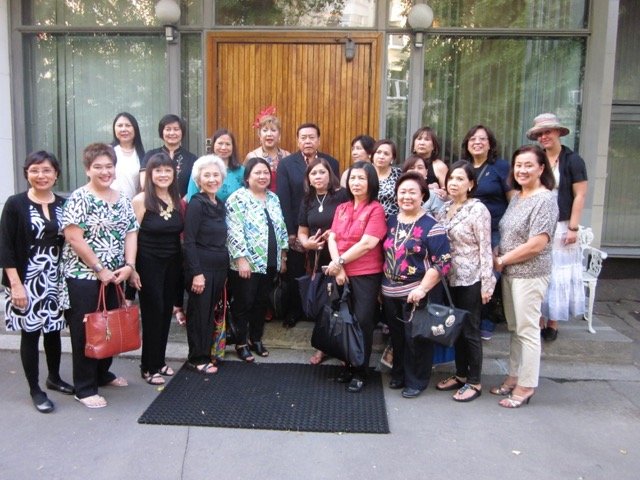
Alumnae of St. Theresa’s College, Quezon City, on a Russian tour visiting then- Philippine Ambassador to Moscow and his wife, Victor and Connie Garcia (STCQC HS ’67).
When Leny Roco Fabul, the Class ’67 president, asked me about organizing the class trip, I readily recommended Bessie Gonzalez Escalona, my student from HS ’65, to be their travel advisor. Bessie owned and managed Voyager Travel and Tours, with whom I had traveled a few times with other Theresians. and we had unanimously found her service truly outstanding.
I also contacted Bessie to ask her to assist Leny because I knew that applying for Russian visas at that time was a real challenge and that planning the itinerary was quite complicated. During my previous three trips with her, I had found her equal to any travel problem we have had to face. She was not only knowledgeable and competent in dealing with her travel associates, but also understanding and accommodating towards her passengers.
In no time, both Leny and Bessie got to work, and soon our group of 25 was ready to leave from various cities: Manila and Los Angeles, San Francisco and New York, Baltimore and Boston, to converge at about the same time that day, Sunday, July 17, 2011, at the Sheremetyevo Airport in Moscow.
The first week spent in Moscow was filled with excitement. We enjoyed simply seeing one another. We had so much fun just chitchatting as in most class reunions.
True to expectations, Vic and Connie lavishly entertained us at the ambassador’s residence with sumptuous dinners, which I imagined could be no less grandiose than those tendered for visiting heads of state at Malacañang Palace, the White House or Buckingham Palace. Invariably, Connie regaled us with her amazing experiences in various world capitals as a diplomat’s wife, as well as her personal love story. To this day I am genuinely amused by her narration of her first meeting with Vic, no matter how many times it is retold.
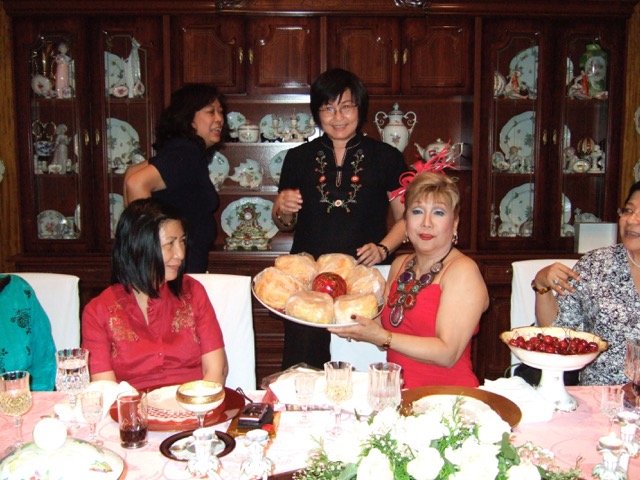
Lynda Sibal and Miyen Verzosa present ensaymada and quest de bola from Manila to Connie Garcia in Moscow.
During the first week in Moscow, sight-seeing was the main activity. We wandered about Red Square taking note of the seemingly impregnable Kremlin Wall and the imposing State Historical Museum, the massive pyramidal lines of Lenin’s Mausoleum and the simple, austere, but moving Tomb of the Unknown Soldier. We marveled at the varicolored onion domes of St. Basil’s Cathedral with their intricate designs, as well as at the eclectic Kazan Cathedral which offered many points of interest to any serious student of art history. These monumental landmarks ringing the huge Red Square have become familiar to the many tourists in Russia who have captured them in photographs and in many picture postcards sent to family and friends. Thanks to my almost-fanatical devotion to journal-writing, I was able to record my impressions and reflections during the whole trip -- the sights and sounds, scents and tastes and feel of everything around me.
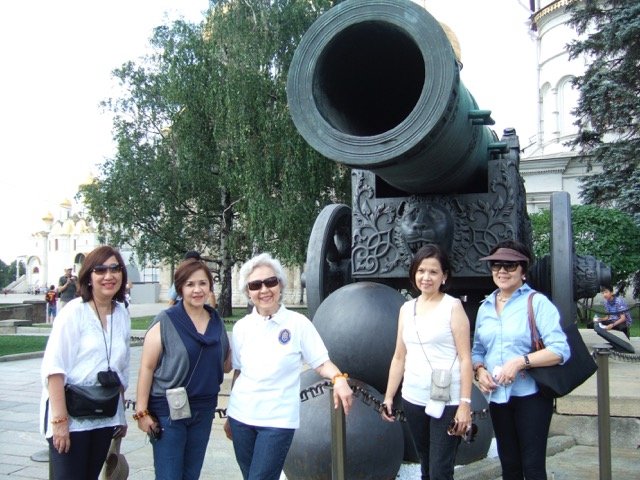
On a tour around the Kremlin were Bessie Escalona, Pochola Narvaez, Lucila (Mrs. D) Dypiangco, Adelaida Goco and Josie Mendoza.
An irresistible magnet to all of us on Red Square was the state shopping mall called GUM. All the women gravitated towards the shops on each level, but after a short while I was mildly disappointed. I remembered my two previous tours of Russia when I had found a wide array of Russian-made souvenirs: matryoshka stacking dolls, amber jewelry, colorful floral woolen shawls and delicate lacquerware. This time the GUM shops seemed to sell mostly imported Western labels: Gucci and Fendi, Ferragamo and Valentino, Louis Vuitton and Givenchy. What a letdown for an inveterate souvenir hunter and shopper!
Fortunately, the official Philippine Ambassador’s residence was not too far from Arbat, the popular pedestrian shopping street. After hastily buying a few items, we found out from Connie that most of the items sold on Arbat had been bought by their vendors at much-discounted wholesale prices at Izmailovo where we were to go the next day. What welcome news to us all! Needless to say, we all bought extra suitcases and carry-on bags for all the souvenirs we were able to buy at eye-popping discount prices at Izmailovo, the shopper’s paradise. It was, indeed, the “168” of Deevee (Divisoria) for Muscovites.
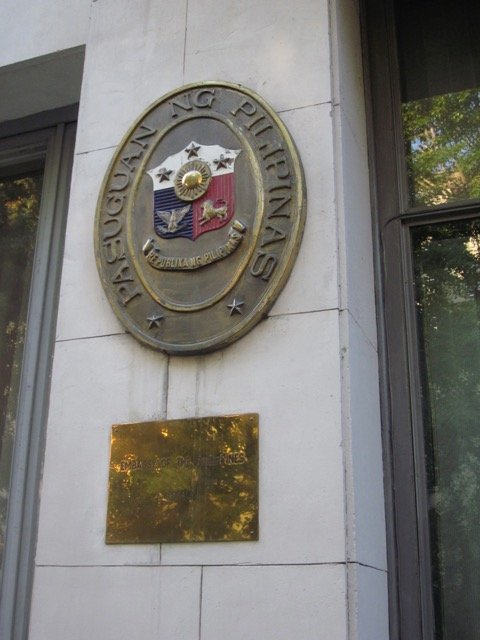
The Philippine EMbassy in Moscow
Day after day in the city brought us to more and more sites to explore. No one was interested in taking a tour of the Moscow Metro stations. Many of us were familiar with the subway systems of major world cities, and viewed them simply as a necessary means to go from place to place. We certainly never expected to see rare artistic attractions at the Moscow Metro stations.
To our surprise, we found out that large droves of tourists actually signed up for tours of these various train stops. Along the walls and across the ceilings were masterful depictions of historical and political scenes, as well as illustrations of everyday life. Our guide did not just show us the best examples of Soviet-era architecture during an hour-and-a-half walking tour, but she also explained Stalin’s vision for the former Soviet Union through grandiose works of visual art — architecture, mosaic, sculptures and paintings.
True to Filipino touristic custom, we engaged in never-ending kodakan. We had group photos of all 25 of us, as well as “class-by-class” groupings and Best Friends Forever (BFF) pairings. Some of us just kept clicking away as our television celebrity, Mel Tiangco, posed in various combinations.
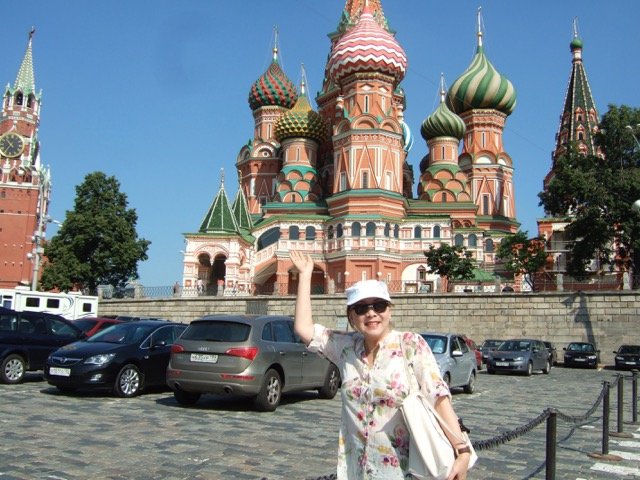
Theresian Mel Tiangco, popular Philippine TV personality, was among my former students in the tour group. Behind her is the Russian Orthodox Saint Basil Cathedral.
My top favorite among Moscow’s tourist attractions was the cemetery right next to the Novodevichy Church and Convent. The list of notables buried there reads like a Who’s Who. Thank God for our Russian guide who was not only proficient in English, but also articulate in explaining the contributions of the Russian greats whose graves we saw — those of writers Anton Chekhov, Nikolai Gogol and Leo Tolstoy; composers Sergei Prokofiev and Dmitri Shostakovich; actor/director Konstantin Stanislavsky and government leaders Nikita Khrushchev and Boris Yeltsin.
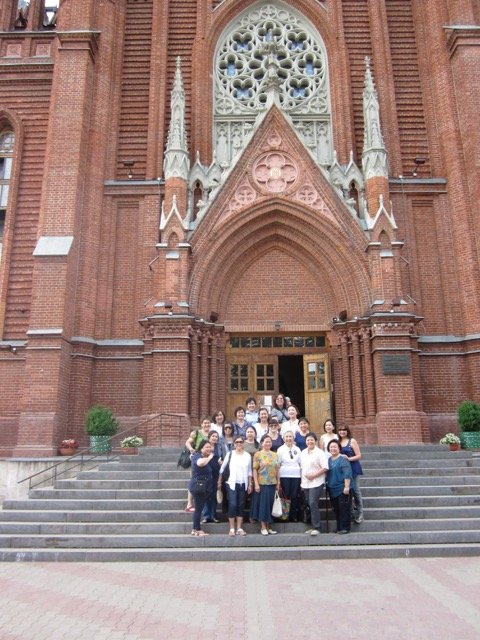
Visiting a Roman Catholic Church in Moscow
In preparing our itinerary, Bessie had included a cultural dance production billed as “Kostroma, a Russian Dance Miracle.” This dazzling program consisted of lively folk dances and lilting songs from the various regions of Russia, each with its own cultural traditions and regional wardrobe styles. The Siberian and Caucasian regional costumes hardly bore any resemblance to those of the Ural Mountains or the Volga River. I imagined scenes from Doctor Zhivago, Brothers Karamazov and Anna Karenina as I sat comfortably in my plush theater seat. No sign at all of the harsh gulags of the Siberian winters or the drab, austere life during the Soviet era, which we imagined when, as convent school girls, we were advised by the nuns to “pray for the conversion of Russia.”
Then it was time to say good-bye to Connie and Vic as we boarded an Aeroflot, the Russian flagship carrier that was to take us to Saint Petersburg. There was a time when the mere thought of Aeroflot scared me (and that was way before the 9/11 terrorism on the World Trade Center). Upon arrival at Pulkovo Airport, we checked in at the Park Inn Hotel in the city’s fashionable district. We lost no time exploring the blocks around the hotel, familiarizing ourselves with places of interest.
The next morning took us to Petrodvorets, aka Peterhof in German. Known to English speakers as the Grand Palace of Peter the Great, it is actually a series of palaces and gardens commissioned by the tsar as a direct response to Louis XIV’s Versailles. If Versailles was magnifique, Petrovorets was velikolepnyy. (Although the word awesome seems to have lost its original meaning due to its current overuse, misuse and abuse, it is still the one word I would use to describe Petrodvorets to indicate its grandeur, excellence and majesty.)
It was on our second night in Saint Petersburg when my most unforgettable experience of the whole trip occurred.
A Medical Emergency
“You will not die of a heart attack. Your heart is strong; it will go on beating for many more years.”
The gentle voice of Dr. Kennedy, my Kaiser Hospital cardiologist in Los Angeles, echoed in my mind as I lay wide awake in bed. At 2:38 a.m. of that Sunday morning of July 24, 2011, I tossed and turned trying to fall back to sleep after getting up to go to the restroom. My mind was wide awake. I realized I was in Room 709 of the Park Inn Hotel on Nevsky Prospekt in Saint Petersburg, Russia, 5,600 miles away from home. Since Saint Petersburg was ten hours ahead of Los Angeles, it was still 4:38 p.m., Saturday -- the day before -- there. My husband Oscar would most likely be on his way to St. Stephen’s Church for the anticipated Sunday Mass at 5:00 p.m. Since neither of us had a cellphone then, there was no way I could possibly get in touch with him.
I was all alone in the room because I had requested Bessie to put me in a single room instead of the double everyone else had. I wanted to be alone so I would not accidentally wake up a roommate during my frequent nocturnal trips to the restroom. I also wanted the solitude to write on my journal late into the night without having to keep a roommate awake.
The gentle voice of Dr. Kennedy kept coming back to me. I tried to replay it in my head; but the sound of his voice seemed to fade as my heart began to knock and pound at my upper left rib cage. My chest hurt as my pulse went racing wildly. I could not slow it down even with the deep breathing I had been taught to do. This must be arrhythmia, I thought. Rapid heartbeat. The beat was so fast that I could not count how many times they came per minute. Even more alarming were the intervals each time my heart would stop beating. Suppose my heart does not restart right away after it stops? Suppose it just stops beating and never restarts? How long would it take before I die?
Why didn’t I bring my sphygmomanometer? I had always brought along my small digital blood pressure machine each time I went on a long trip. Why didn’t I bring it this time? Could this be my time? I had often heard,”Kapag oras mo na, oras mo na.” When it’s your time, it’s your time.
Unable to keep my mind focused on Dr. Kennedy’s voice and afraid to die alone in my room, I decided to ring Bessie. She answered on the second ring. “I am sick, Bessie.” I said. “I think I need to call a doctor. Could you ask the front desk to send one?”
“I’ll be right there,” Bessie assured me.
When Bessie knocked at my door, I was ready to open it and let her in. She was not alone. Right behind her was her roommate Melanie who should have been my roommate if I had not requested Bessie for the single room. Upon seeing me in my miserable pained condition, Bessie decided to call for a doctor.
“Wait, wait!” It was Melanie. “Why don’t you just call Tina in the room next door. She should know what to do with Mrs. D; her husband is a vet.” I didn’t know whether to laugh or scream. I slumped on my bed in absolute dismay.
“Maybe you could just call long distance to Moscow and ask Vic and Connie what we should do.” Another wise suggestion from Melanie. Apparently this one made more sense to Bessie because she was already dialing before I could say a word.
Soon Vic was on the line. “What happened to Mrs. D?”
Bessie described my rapid and irregular heartbeat, so rapid that it was making me extremely tired. I was so short of breath, I could hardly talk. I could tell that Bessie was deeply concerned but, thank God, she was composed, very calm, as Melanie was in a panic, insisting on calling her husband in Orange County. What for, I never found out.
Vic informed Bessie that he would call his consul in St. Petersburg to ask him to go to Park Inn Hotel to assist me. We prayed as we waited for word from either Vic or the Philippine consul. Finally, the phone rang; it was Vic again.
“I’m sorry but the consul in Saint Petersburg had gone on a short weekend holiday and is not in town. He is not expected to be back at the consulate until late tonight. I think you should call a doctor. Don’t worry. There are very good doctors in Russia.”
When the doctor came, he had a portable EKG machine, plus everything a doctor is expected to bring when making a house call. He hooked me up on the machine, took my blood pressure and other vitals. Then in his Russian English, he said, “You need to go to the hospital for your paroxysmal atrial fibrillation.”
“Oh no,” I said, “we’re flying to Prague the day after tomorrow.”
“I don’t think you can fly in that condition, and I don’t know if and when your atrial fibrillation is going to stop if you just stay here at the hotel. If you go to the hospital we will give you medication intravenously that can stop your rapid heartbeat.”
Bessie’s advice was comforting. “Mrs. D, I think you should go to the hospital as the doctor says. I will go with you.”
“What about the rest of the girls? How will they go on their tour today? What will everyone be doing if you don’t go with them?”
“Don’t worry, Mrs. D. I will call the Saint Petersburg guide who was with us yesterday. She will also be guiding the group to the Hermitage today. She is an experienced guide and can take care of everyone. She would not really need me.”
I knew better but I did not argue.
“So how do we get to the hospital?” I asked Bessie.
It was the doctor who answered. “Don’t worry, I have the ambulance downstairs with me. It can take you to Euromed Clinic.”
“Imagine, this doctor the hospital had sent me coming with an ambulance already!” I thought. “I wonder if every person who calls for a doctor is expected to go on their ambulance.”
A hotel porter wheeled me down the elevator to the lobby where all the girls sat waiting for the dining room to open for breakfast. Many of them looked up at me in shock with puzzled questioning eyes. They were wondering what had happened to me as my wheelchair sped towards the waiting ambulance outside the entrance door. One face that stood out to me clearly asking, “What happened, Mrs. D?” was Lynda Sibal. She was full of concern and sympathy.
With Bessie in the passenger seat, I was lifted to a gurney that was pushed into the ambulance. With siren blaring and red light flashing, the ambulance sped away screeching through the still-silent streets of Saint Petersburg. I was immediately admitted to the ER of Euromed Clinic before being transferred to my private room. There I was hooked to the IV and oxygen tubes by a non-English speaking nurse. A doctor, different from the one who saw me at the hotel, introduced himself as the cardiologist and ordered for me one test after another.

The health facility where I spent my unforgettable day in Saint Petersburg, Russia.
Meanwhile, poor Bessie sat quietly at the foot of my hospital bed. We were quiet whenever the nurse or a doctor would check on me. Whenever we were left to ourselves, we would talk.
Ever solicitous, Bessie would ask me how I felt, whether there was any pain, reminding me not to worry and repeatedly reassuring me that everything would be fine. I remember telling her that I wasn’t really afraid of dying, even in this foreign country far away from home. “I’m really more worried about you having to take my body home in a casket . . . and about Oscar finding out I had died so far away from him. How would he take it? He may want to fly over here to get me, but that would be a real hassle. I don’t think he can do that in his condition. And how would he take it when he got to the airport to receive my remains? And what about the boys and their families? I will never get to see my grandkids graduate or get married.”
“Oh, Mrs. D, don’t worry. We are all praying. You will go home with all of us.”
“Actually, Bessie, I had been telling God this prayer I had learned when I was much younger. I don’t really pray. I just talk to Him saying:
You know the way for me, you know the time.
Into your hands I trustingly place mine.
Your plan is perfect; it’s borne of perfect love.
You know the way for me; that is enough.
Bessie stayed with me at Euromed Clinic for exactly 12 hours that Sunday. A hospital attendant served me the usual tasteless hospital meal for lunch, but I never found out if Bessie ate at all.
As I was discharged late that afternoon Bessie settled my account. I just assumed that Euromed’s cashier accepted my travel insurance policy coverage, which I had indicated on my admission papers.
By the time we were in Prague the next day, my day at Euromed was practically forgotten. The visit to the Santo Niño de Praga at the Carmelite church found us posing for innumerable pictures. We had several shots before the gate with the bas relief of the Carmelite logo — the same logo we had on our STC pins, pens and pencils, book covers and school bags — the three stars surmounting the cross that looks like the letter T.
In Prague, we were invited to a restaurant for an authentic Czech dinner by no less than the then-Philippine Ambassador to the Czech Republic, the Honorable Evelyn Austria Garcia, also an STC alumna.
As we flew home to our various cities, we carried with us not only our countless souvenirs and pasalubongs, but also priceless memories. We went home tired but happy.
Until a couple of weeks later. I received an important-lookinq letter in a legal-size envelope with a foreign stamp. The return address bore the big bold letters that read EUROMED. Inside was a copy of the receipt for the payment made upon my discharge on July 24, 2011. Three thousand euros! It was paid with the VISA card of Visitacion Escalona. Oh no! Bessie had used her credit card to pay for my medical bills!
Oscar and I immediately made an overseas call to Bessie, not even thinking of the time difference between Manila and Los Angeles. When Bessie answered I blurted out, “Bessie, I’m so sorry your Visa was charged for my hospitalization. I will file a claim with Travel Guard and Kaiser who will surely reimburse me. But I will not wait for their checks. I will immediately send you a check for the three thousand euros (over US $5,000) through your brother in LA.
“I’m not worried, Mrs. D. I knew you would pay it back.”
Such trust! I realized what a true friend I had in Bessie. She embodies the saying, “A friend in need is a friend indeed.” Now, when anybody asks me to define friendship, I ha
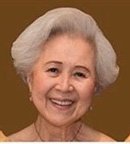
Lucila Ocampo Dypiangco, a teacher of 42 years (11 years at St. Theresa’s College, Quezon City and 31 years with the Los Angeles School District) is married to Oscar Dypiangco with whom she shares their 4 sons and 8 grandchildren. They have been traveling extensively, especially since their retirement in 2000.







No comments:
Post a Comment